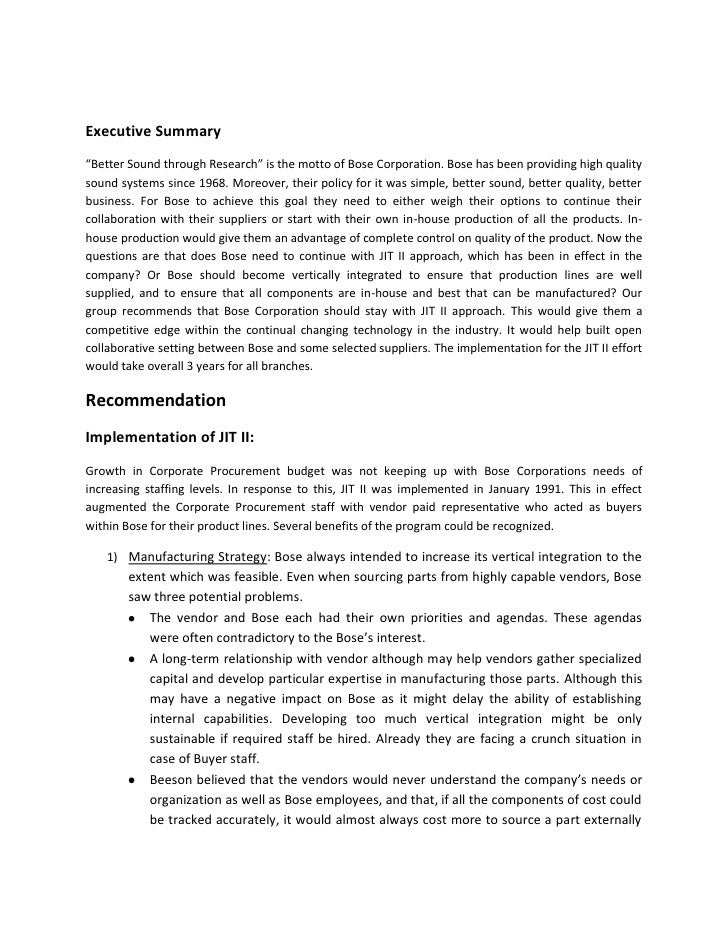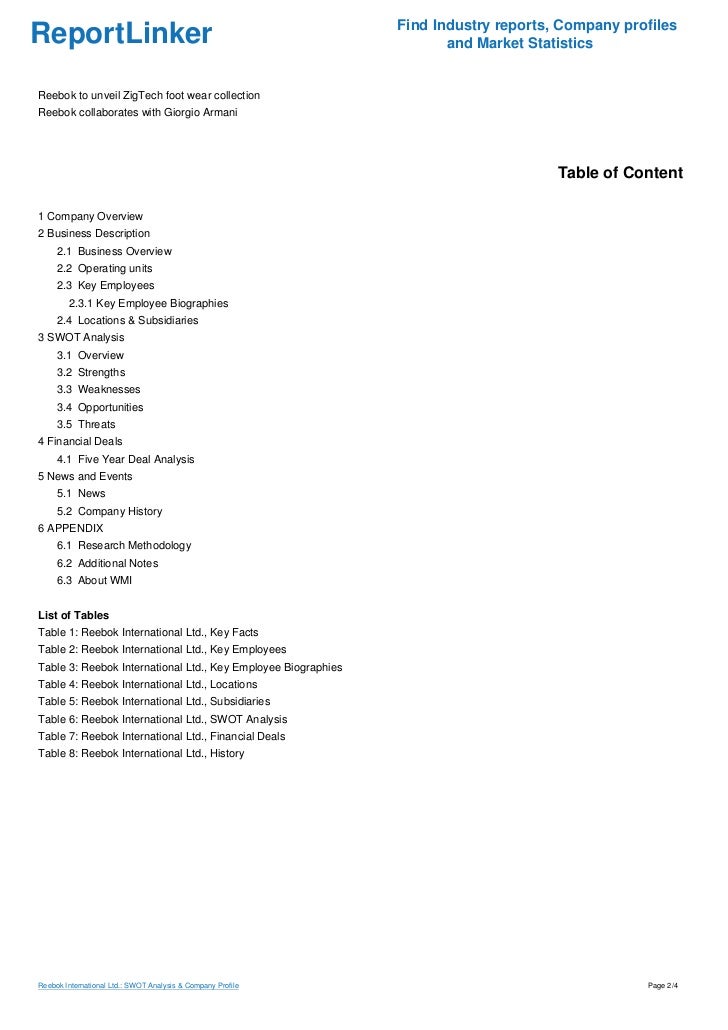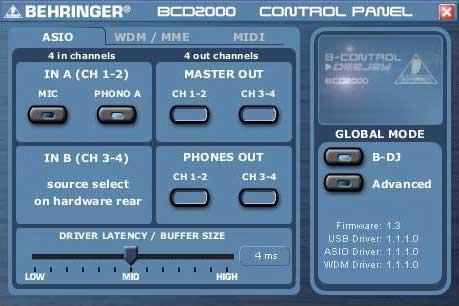Bose Corporation The Jit Ii Program A Case Study
Harvard Business Case Studies Solutions - Assignment Help

- Sep 1, 1998 - Before it started its JIT II program, Bose would forecast customer demand, set. JIT II partnerships also can prove to be a case study in faith.
- Access to case studies expires six months after purchase date. Publication Date: March 08, 1994 Bose Corp. Is evaluating an unusual plan to manage relationships with vendors that supply components for Bose speakers.
Bose Corp.: The JIT II Program (A) is a Harvard Business (HBR) Case Study on Technology & Operations , Fern Fort University provides HBR case study assignment help for just $11. Our case solution is based on Case Study Method expertise & our global insights.

Technology & Operations Case Study Authors :: Roy D. Shapiro, Bruce Isaacson
Mar 8, 1994 - Access to case studies expires six months after purchase date. Is evaluating an unusual plan to manage relationships with.
Case Study Description
Bose Corp. is evaluating an unusual plan to manage relationships with vendors that supply components for Bose speakers. The company must decide: 1) which planning and ordering activities should be performed by Bose and which can be performed by vendors, 2) how much access vendors should have to Bose computer systems and facilities, and 3) how to adapt vendor relations as the company grows or as markets change. Students are asked to consider both the buyer's and the vendor's perspective on the buyer-seller relationship.
Joint ventures, Manufacturing, Strategic planning, Supply chain
[10 Steps] Case Study Analysis & Solution
Bose Corporation The Jit Ii Program A Case Study
Step 1 - Reading up Harvard Business Review Fundamentals on the Technology & Operations
Even before you start reading a business case study just make sure that you have brushed up the Harvard Business Review (HBR) fundamentals on the Technology & Operations. Brushing up HBR fundamentals will provide a strong base for investigative reading. Often readers scan through the business case study without having a clear map in mind. This leads to unstructured learning process resulting in missed details and at worse wrong conclusions. Reading up the HBR fundamentals helps in sketching out business case study analysis and solution roadmap even before you start reading the case study. It also provides starting ideas as fundamentals often provide insight into some of the aspects that may not be covered in the business case study itself.
Step 2 - Reading the Bose Corp.: The JIT II Program (A) HBR Case Study
To write an emphatic case study analysis and provide pragmatic and actionable solutions, you must have a strong grasps of the facts and the central problem of the HBR case study. Begin slowly - underline the details and sketch out the business case study description map. In some cases you will able to find the central problem in the beginning itself while in others it may be in the end in form of questions. Business case study paragraph by paragraph mapping will help you in organizing the information correctly and provide a clear guide to go back to the case study if you need further information.
My case study strategy involves -
- Marking out the protagonist and key players in the case study from the very start.
- Drawing a motivation chart of the key players and their priorities from the case study description.
- Refine the central problem the protagonist is facing in the case and how it relates to the HBR fundamentals on the topic.
- Evaluate each detail in the case study in light of the HBR case study analysis core ideas.
Step 3 - Bose Corp.: The JIT II Program (A) Case Study Analysis
Once you are comfortable with the details and objective of the business case study proceed forward to put some details into the analysis template. You can do business case study analysis by following Fern Fort University step by step instructions -
- Company history is provided in the first half of the case. You can use this history to draw a growth path and illustrate vision, mission and strategic objectives of the organization. Often history is provided in the case not only to provide a background to the problem but also provide the scope of the solution that you can write for the case study.
- HBR case studies provide anecdotal instances from managers and employees in the organization to give a feel of real situation on the ground. Use these instances and opinions to mark out the organization's culture, its people priorities & inhibitions.
- Make a time line of the events and issues in the case study. Time line can provide the clue for the next step in organization's journey. Time line also provides an insight into the progressive challenges the company is facing in the case study.
Step 4 - SWOT Analysis of Bose Corp.: The JIT II Program (A)
Once you finished the case analysis, time line of the events and other critical details. Focus on the following -
- Zero down on the central problem and two to five related problems in the case study.
- Do the SWOT analysis of the Bose Corp.: The JIT II Program (A) . SWOT analysis is a strategic tool to map out the strengths, weakness, opportunities and threats that a firm is facing.
- SWOT analysis and SWOT Matrix will help you to clearly mark out - Strengths Weakness Opportunities & Threats that the organization or manager is facing in the Bose Corp.: The JIT II Program (A)
- SWOT analysis will also provide a priority list of problem to be solved.
- You can also do a weighted SWOT analysis of Bose Corp.: The JIT II Program (A) HBR case study.
Step 5 - Porter 5 Forces / Strategic Analysis of Industry Analysis Bose Corp.: The JIT II Program (A)
In our live classes we often come across business managers who pinpoint one problem in the case and build a case study analysis and solution around that singular point. Business environments are often complex and require holistic solutions. You should try to understand not only the organization but also the industry which the business operates in. Porter Five Forces is a strategic analysis tool that will help you in understanding the relative powers of the key players in the business case study and what sort of pragmatic and actionable case study solution is viable in the light of given facts.
Step 6 - PESTEL, PEST / STEP Analysis of Bose Corp.: The JIT II Program (A)
Another way of understanding the external environment of the firm in Bose Corp.: The JIT II Program (A) is to do a PESTEL - Political, Economic, Social, Technological, Environmental & Legal analysis of the environment the firm operates in. You should make a list of factors that have significant impact on the organization and factors that drive growth in the industry. You can even identify the source of firm's competitive advantage based on PESTEL analysis and Organization's Core Competencies.
Step 7 - Organizing & Prioritizing the Analysis into Bose Corp.: The JIT II Program (A) Case Study Solution
Once you have developed multipronged approach and work out various suggestions based on the strategic tools. The next step is organizing the solution based on the requirement of the case. You can use the following strategy to organize the findings and suggestions.
- Build a corporate level strategy - organizing your findings and recommendations in a way to answer the larger strategic objective of the firm. It include using the analysis to answer the company's vision, mission and key objectives , and how your suggestions will take the company to next level in achieving those goals.
- Business Unit Level Solution - The case study may put you in a position of a marketing manager of a small brand. So instead of providing recommendations for overall company you need to specify the marketing objectives of that particular brand. You have to recommend business unit level recommendations. The scope of the recommendations will be limited to the particular unit but you have to take care of the fact that your recommendations are don't directly contradict the company's overall strategy. For example you can recommend a low cost strategy but the company core competency is design differentiation.
- Case study solutions can also provide recommendation for the business manager or leader described in the business case study.
Step 8 -Implementation Framework
The goal of the business case study is not only to identify problems and recommend solutions but also to provide a framework to implement those case study solutions. Implementation framework differentiates good case study solutions from great case study solutions. If you able to provide a detailed implementation framework then you have successfully achieved the following objectives -
- Detailed understanding of the case,
- Clarity of HBR case study fundamentals,
- Analyzed case details based on those fundamentals and
- Developed an ability to prioritize recommendations based on probability of their successful implementation.
Implementation framework helps in weeding out non actionable recommendations, resulting in awesome Bose Corp.: The JIT II Program (A) case study solution.
Jit Ii Definition
Step 9 - Take a Break
Once you finished the case study implementation framework. Take a small break, grab a cup of coffee or whatever you like, go for a walk or just shoot some hoops.
Step 10 - Critically Examine Bose Corp.: The JIT II Program (A) case study solution
After refreshing your mind, read your case study solution critically. When we are writing case study solution we often have details on our screen as well as in our head. This leads to either missing details or poor sentence structures. Once refreshed go through the case solution again - improve sentence structures and grammar, double check the numbers provided in your analysis and question your recommendations. Be very slow with this process as rushing through it leads to missing key details. Once done it is time to hit the attach button.
SUPPLY CHAIN MANAGEMENT AT BOSE CORPORATION
Bose Corporation, headquartered in Framingham, Massachusetts,offers an excellent example of integrated supply chain management.Bose, a producer of audio premium speakers used in automobiles,high-fidelity systems, and consumer and commercial broadcastingsystems, was founded in 1964 by Dr. Bose of MIT. Bose currentlymaintains plants in Massachusetts and Michigan as well as Canada,Mexico, and Ireland. Its purchasing organization, whiledecentralized, has some overlap that requires coordination betweensites. It manages this coordination by using conference callsbetween managers, electronic communication, and jointproblem-solving. The company is moving toward single sourcing manyof its 800 to 1,000 parts, which include corrugated paper, particleboard and wood, plastic injected molded parts, fasteners, glues,woofers, and fabric.
Some product components, such as woofers, are sourced overseas.For example, at the Hillsdale, Michigan, plant, foreign sourcingaccounts for 20% of purchases, with the remainder of supplierslocated immediately within the state of Michigan. About 35% of theparts purchased at this site are single sourced, with approximatelyhalf of the components arriving with no incoming inspectionperformed. In turn, Bose ships finished products directly to Delco,Honda, and Nissan and has a record of no missed deliveries. Normallead time to customers is 60 working days, but Bose can expediteshipments in one week and airfreight them if necessary.
The company has developed a detailed supplier performance systemthat measures ontime delivery, quality performance, technicalimprovements, and supplier suggestions. A report is generated twicea month from this system and sent to the supplier providingfeedback about supplier performance. If there is a three-week trendof poor performance, Bose will usually establish a specific goalfor improvement that the supplier must attain. Examples include 10%delivery improvement every month until 100% conformance isachieved, or 5% quality improvement until a 1% defect level isreached over a four-month period. In one case, a supplier sent arejected shipment back to Bose without explanation and with nocorrective action taken. When no significant improvement occurred,another supplier replaced the delinquent supplier.
Bose has few written contracts with suppliers. After six monthsof deliveries without rejects, Bose encourages suppliers to applyfor a certificate of achievement form, signifying that they arequalified suppliers. One of the primary criteria for gainingcertification involves how well the supplier responds to correctiveaction requests. One of the biggest problems observed is thatsuppliers often correct problems on individual parts covered by acorrective action form without extending these corrective actionsto other part families and applicable parts. Bose has adopted aunique system of marrying just-in-time (JIT) purchasing with globalsourcing. Approximately half of the dollar value of Bose’s totalpurchases are made overseas, with the majority of the sourcing donein Asia. Because foreign sourcing does not support justin-timedeliveries, Bose “had to find a way to blend low inventory withbuying from distant sources,” says the director of purchasing andlogistics for Bose.
Visualizing itself as a customer-driven organization, Bose nowuses a sophisticated transportation system—what Bose’s manager oflogistics calls “the best EDI system in the country.” Workingclosely with a national less-than-truckload carrier for the bulk ofits domestic freight movements, including shipments arriving at aU.S. port from oversees, Bose implemented an electronic datainterchange (EDI) system that does much more than simple tracking.The system operates close to real time and allows two-waycommunication between every one of the freight handler’s 230terminals and Bose. Information is updated several times daily andis downloaded automatically, enabling Bose to perform shippinganalysis and distribution channel modeling to achieve reliablelowest total cost scenarios. The company can also request removalfrom a terminal of any shipment that it must expedite with an airshipment. This state-of-the-art system provides a snapshot of whatis happening on a daily basis and keeps Bose’s managers on top ofeveryday occurrences and decisions. Management proactively manageslogistics time elements in pursuit of better customer service. Thenext step is to implement this system with all major suppliersrather than just with transportation suppliers. In the future, Boseplans to automate its entire materials system.
Perhaps one of the most unique features of Bose’s procurementand logistics system is the development of JIT II. The basicpremise of JIT II is simple: The person who can do the best job ofordering and managing inventory of a particular item is thesupplier himself. Bose negotiated with each supplier to provide afull-time employee at the Bose plant who was responsible forordering, shipping, and receiving materials from that plant, aswell as managing on-site inventories of the items. This was donethrough an EDI connection between Bose’s plant and the supplier’sfacility. Collocating suppliers and buyers was so successful thatBose is now implementing it at all plant locations. In fact, manyother companies have also begun to implement collocation ofsuppliers.
Assignment Questions The following assignment questionsrelate to ideas and concepts presented throughout this text. 1. Whyis purchased quality so important to Bose? 2. Can a just-in-timepurchase system operate without total quality from suppliers? 3.Bose is moving toward single sourcing many of its purchased partrequirements. Discuss why the company might want to do this. Arethere any risks to that approach? 4. Why is it necessary to enterinto a longer-term contractual arrangement when pursuingarrangements like the one Bose has with its domestictransportationcarrier?
